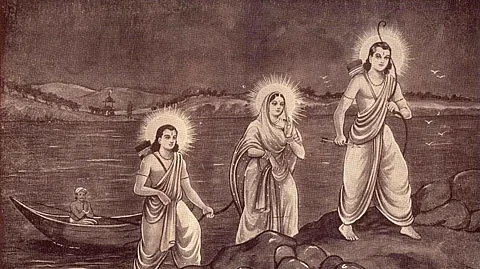

The ninth day of Chaitra Navaratri is celebrated as Rama Navami, the birthday of Lord Rama. It is also the last day of Nava Durga Sadhana dedicated to Devi Siddhidatri, one of the forms of Goddess Durga. Rama is considered the seventh Avatara of Lord Vishnu (one of the Gods in the Hindu Trinity). Let’s begin the post on a ceremonious note by listening to a bhajan about the birth of Lord Rama. It has been sung by noted Hindustani classical music vocalist, Pandit Channulal Mishra.
The tale of Rama’s life has been captured in the famous epic Ramayana written during the 7th to 4th centuries BCE by sage Valmiki. Written in Sanskrit, Ramayana consists of nearly 24,000 verses. It is not a fictional account but an Itihasa (a historical record of past events). Indeed, there are exaggerations as expected in the epic writing style; however, most places mentioned in the narrative can be traced to real geographic locations in the Indian Subcontinent. For example, Kishkindha, where Rama and Lakshmana met the monkey king Sugriva, and Hanumana is the present-day Hampi in Karnataka.
Ramayana Outside India
Several translations and adaptations of Ramayana exist across Indian languages. The epic has culturally influenced many South-East Asian countries, such as Bangladesh, Nepal, Cambodia, Indonesia, Laos, Malaysia and Thailand. All these nations have their own versions of the tale. Sometimes the myth is mixed with Buddhist stories and local folktales. You can check out the different dramatic traditions of Ramayana in South East Asian countries here.
Indian Culture and Ramayana
In India, the tale of Ram and Sita is woven into the cultural consciousness. Ram epitomises justice, fairness and devotion. He is a dutiful son, a compassionate and just ruler, and a devoted husband, although some of his decisions pertaining to Sita are quite debatable. The reign of Rama gave birth to the term ‘Ramrajya’ — an epithet for a peaceful and just rule or kingdom.
In India, many festivals are centred around the main events of the epic. For example, Dusshera marks the day when Rama killed the demon king Ravana. The return of Rama, Sita and Laxmana is celebrated on Diwali, the festival of lights. Rama Katha (the story of Rama) has inspired many visual and performing art forms as well as traditional arts and crafts. Let’s look at some of them.
Visual Arts
Ram Katha is a common theme across many dance forms in India. Popular stories from the epic are enacted in dance and drama forms such as Yakshgana, Kuchipudi, Bharatanatyam and Kathak.
Ramleela is a dramatic enactment of the main events from Ramayana. A very popular form in Northen India, Ramleela is performed over nine days during the Sharada Navaratri.
A Kathakali Performance Based on Ramayana
Ramayana and Literature
Apart from the regional and Southeast Asian versions of Ramayana, the epic has also inspired alternate writings, poetry and retellings from the point of view of different characters. Many women writers have told the tale from Sita’s perspective. Sita does not have much voice in the original text, apart from being a devoted, and unquestioning wife to Rama. Women writers have opened the debate around patriarchy and questioned the decisions of Rama. Some of these alternate retellings include Chandrabati’s Bengali Ramayana written in the 16th century and Ramayana Vishvrukshum by Telugu Marxist writer Ranganayakamma. Hindi writer Maithili Sharan Gupta chose Urmila (Laxmana’s wife) as the main protagonist of his work ‘Saket’. In recent times, Kavita Kane’s historical fiction ‘Sita’s sister’ was a retelling of Ramayana from Urmila’s perspective.
Through many ages, Ramayana has lent itself to different interpretations. What one cannot negate is the indelible impact of this work on the culture and psyche of the Indian Subcontinent.
Navaratri is the best time to perform the most beautiful and powerful NavDurga Sadhana to deepen your bond with the divine mother.
